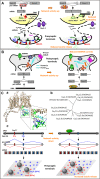Emerging Roles of Activity-Dependent Alternative Splicing in Homeostatic Plasticity
- PMID: 32477067
- PMCID: PMC7235277
- DOI: 10.3389/fncel.2020.00104
Emerging Roles of Activity-Dependent Alternative Splicing in Homeostatic Plasticity
Abstract
Homeostatic plasticity refers to the ability of neuronal networks to stabilize their activity in the face of external perturbations. Most forms of homeostatic plasticity ultimately depend on changes in the expression or activity of ion channels and synaptic proteins, which may occur at the gene, transcript, or protein level. The most extensively investigated homeostatic mechanisms entail adaptations in protein function or localization following activity-dependent posttranslational modifications. Numerous studies have also highlighted how homeostatic plasticity can be achieved by adjusting local protein translation at synapses or transcription of specific genes in the nucleus. In comparison, little attention has been devoted to whether and how alternative splicing (AS) of pre-mRNAs underlies some forms of homeostatic plasticity. AS not only expands proteome diversity but also contributes to the spatiotemporal dynamics of mRNA transcripts. Prominent in the brain where it can be regulated by neuronal activity, it is a flexible process, tightly controlled by a multitude of factors. Given its extensive use and versatility in optimizing the function of ion channels and synaptic proteins, we argue that AS is ideally suited to achieve homeostatic control of neuronal output. We support this thesis by reviewing emerging evidence linking AS to various forms of homeostatic plasticity: homeostatic intrinsic plasticity, synaptic scaling, and presynaptic homeostatic plasticity. Further, we highlight the relevance of this connection for brain pathologies.
Keywords: P/Q-type Ca2+ channels; alternative splicing; homeostatic plasticity; homer1; repressor element 1 silencing transcription factor (REST).
Copyright © 2020 Thalhammer, Jaudon and Cingolani.
Figures


Similar articles
-
All for One But Not One for All: Excitatory Synaptic Scaling and Intrinsic Excitability Are Coregulated by CaMKIV, Whereas Inhibitory Synaptic Scaling Is Under Independent Control.J Neurosci. 2017 Jul 12;37(28):6778-6785. doi: 10.1523/JNEUROSCI.0618-17.2017. Epub 2017 Jun 7. J Neurosci. 2017. PMID: 28592691 Free PMC article.
-
Endogenous Tagging Reveals Differential Regulation of Ca2+ Channels at Single Active Zones during Presynaptic Homeostatic Potentiation and Depression.J Neurosci. 2019 Mar 27;39(13):2416-2429. doi: 10.1523/JNEUROSCI.3068-18.2019. Epub 2019 Jan 28. J Neurosci. 2019. PMID: 30692227 Free PMC article.
-
Mechanisms of homeostatic plasticity in the excitatory synapse.J Neurochem. 2016 Dec;139(6):973-996. doi: 10.1111/jnc.13687. Epub 2016 Jul 1. J Neurochem. 2016. PMID: 27241695 Review.
-
Control of Homeostatic Synaptic Plasticity by AKAP-Anchored Kinase and Phosphatase Regulation of Ca2+-Permeable AMPA Receptors.J Neurosci. 2018 Mar 14;38(11):2863-2876. doi: 10.1523/JNEUROSCI.2362-17.2018. Epub 2018 Feb 13. J Neurosci. 2018. PMID: 29440558 Free PMC article.
-
Homeostatic Regulation of Motoneuron Properties in Development.Adv Neurobiol. 2022;28:87-107. doi: 10.1007/978-3-031-07167-6_4. Adv Neurobiol. 2022. PMID: 36066822 Review.
Cited by
-
Opioid Use Disorder and Alternative mRNA Splicing in Reward Circuitry.Genes (Basel). 2022 Jun 10;13(6):1045. doi: 10.3390/genes13061045. Genes (Basel). 2022. PMID: 35741807 Free PMC article.
-
Exitron splicing of odor receptor genes in Drosophila.Proc Natl Acad Sci U S A. 2024 Mar 26;121(13):e2320277121. doi: 10.1073/pnas.2320277121. Epub 2024 Mar 20. Proc Natl Acad Sci U S A. 2024. PMID: 38507450 Free PMC article.
-
Targeting Alternative Splicing as a Potential Therapy for Episodic Ataxia Type 2.Biomedicines. 2020 Sep 5;8(9):332. doi: 10.3390/biomedicines8090332. Biomedicines. 2020. PMID: 32899500 Free PMC article. Review.
-
Age-related demethylation of the TDP-43 autoregulatory region in the human motor cortex.Commun Biol. 2021 Sep 21;4(1):1107. doi: 10.1038/s42003-021-02621-0. Commun Biol. 2021. PMID: 34548609 Free PMC article.
-
Aberrant encoding of event saliency in the orbitofrontal cortex following loss of the psychiatric-associated circular RNA, circHomer1.Transl Psychiatry. 2024 Nov 28;14(1):480. doi: 10.1038/s41398-024-03188-0. Transl Psychiatry. 2024. PMID: 39609379 Free PMC article.
References
LinkOut - more resources
Full Text Sources
Research Materials
Miscellaneous

